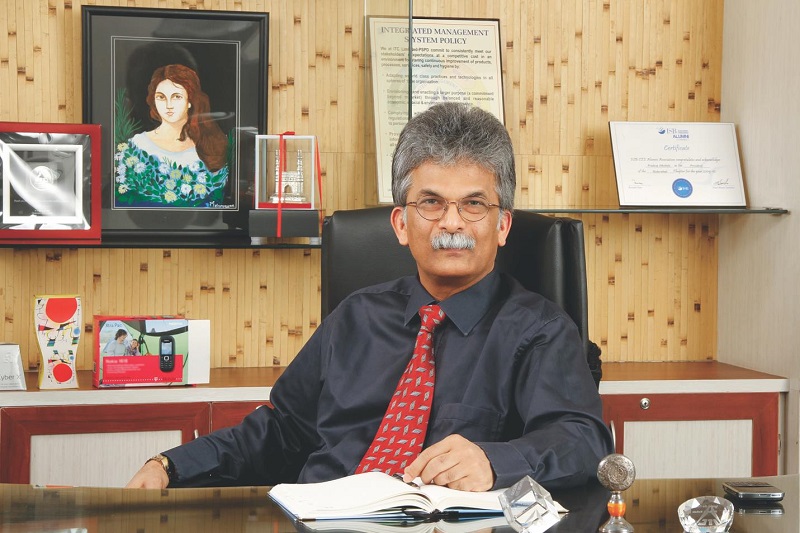
I have experienced positive developments in ecosystem of the Industry. There is more dialogue, effort to understand each other’s issues and intentions of resolution, says Mr. Pradeep Dhobale who spearheaded ITC – PSPD over a long period with tremendously amazing outcomes.
Mr. Pradeep Vasant Dhobale’s name is sure to be remembered as a leader full of novel, progressive and prolific ideas which not only have been instrumental in turning around the fortunes of ITC – Bhadrachalam, but also have given a certain desired direction to the Indian paper industry as whole.
Mr. Dhobale is a Chemical Engineer from IIT, Mumbai. After he was inducted as a Management Trainee in the erstwhile ITC Bhadrachalam Paperboards Limited (ITC Bhadrachalam) in January 29, 1977, Mr. Dhobale donned many caps at ITC and was made the Chief Executive of Paperboards and Speciality Papers Division (PSPD) at ITC Limited in 2002 (following the amalgamation of ITC Bhadrachalam Paperboards with ITC in 2002, and subsequent merger of Tribeni).
Innovations are Mr. Dhobale’s knack and he is predisposed of trying untried ideas and plans to success. He is rightly credited with a sort of renaissance of ITC – Bhadrachalam, which is now probably the largest single-source paper mill in the country. Mr. Dhobale’s groundbreaking clonal propagation program enlivened 100,000 hectares through plantations; and as a result, an improvement in profit margin happened and external risks mitigated.
He was inducted on the ITC board and finally served as an Executive Director of ITC Limited from January 3, 2011 to December 6, 2015, during which he held the responsibility for finance apart from paperboards, specialty paper and packaging.
His extensive experience in the pulp and paper industry would keep giving ample insights to coming generations of leaders in solving key bottlenecks and furthering the interest of the entire industry Paper Mart decided to interview Mr. Dhobale on a series of questions that concerns the industry, and whose answers would better serve as pointers for many. Excerpts:
You spent close to four decades at ITC – from joining on January 29, 1977 as a Management Trainee to becoming Executive Director of ITC Limited from January 3, 2011 with donning various other significant roles in between. What do you remember most about this long stint? (Tell us only from company’s perspective here).
I distinctly remember several landmarks in the areas of productivity, quality, safety and profitability, achieved by Team PSPD, during this long journey. But if I have to single out one achievement, it has to be the growth of ITC PSPD in first decade of this millennium. It is unique because it matches with liberalised India story which began in mid to late nineties. Using ITC’s financial muscle, we repositioned the business for global competition. We had doubled our size in first two decades of our existence. We grew five times in the third decade. I was fortunate to lead a world class team in this journey. More than the technology, machinery or products, it is the people of ITC PSPD who made all the difference. I, therefore, remember most, the people and interactions with them in my long stint.
You have also been member to many notable industry bodies as well as a nominee by the Ministry of Commerce and Industry as Chairman of the Development Council for Pulp, Paper & Allied Industries for two years; and many such other deliberating bodies. Do you feel that industry and the ecosystem around it have changed much to the liking? Tell us some instances worth notice from your long experience of interaction within and without industry including government. (From the aspect of overall industry and the government).
Whereas there is always scope for improvement in any field, I have experienced positive developments in ecosystem of the industry. There is more dialogue, effort to understand each other’s issues and intentions of resolution. One good example is CREP – Corporate Responsibility for Environmental Protection. There were several interactions between the Government and paper industry associations, and a five year programme was agreed upon to improve environmental performance of the Industry. CREP was a voluntary commitment on part of the Industry at the behest of MoEF, but was successfully implemented as if it was the law.
Another example is interaction between NGO community and industry. Rather than opposing each other, the industry players got themselves audited by a reputed NGO and agreed on an improvement path. The next audit five years later showed a major improvement in environmental performance.
Pulpwood plantation is another example of ecosystem development. Farming community in hinterlands of India, working closely with the industry, has created over 400000 hectares of plantations, which have given triple benefit of employment generation, environmental amelioration and economic benefits to farmers and the industry.
Many of these achievements are a result of regular dialogue among the Industry Bodies, Government, NGOs and farming community.
Coming to the Indian paper industry, you must have noticed the flurry of expansion activities, especially the packaging segment. Do you think these expansions are viable seeing the size of the market here in India? Are you in favour of more expansions? Where do you see the capacity and demand of paper and paperboard in five years from now?
Your question has two issues – market size and viability.
The whole world is looking at India as the market. With our population of 1.2 billion and growing on one side, and rapid growth envisaged in per capita consumption riding on economic growth on the other side, market size should not be an issue. Also, with the Government’s thrust on ‘Make in India’, we should not rule out exports.
Viability is a different issue and will depend on company’s long term vision and cost of capital. To my mind, projects based on indigenous raw material have better chance of returning the cost of capital. Being highly capital intensive, any investment in this industry will have fairly long gestation. But let us not forget that paper machines have a life of over 25 years.
Notwithstanding the digital onslaught and resultant slowdown in growth of certain varieties of paper, demand for paper and board will continue to rise for several decades. I would welcome investments in this sector to meet domestic demand, create employment and avoid foreign exchange outgo. There is a good chance of hitting 20 million tonnes in next five years if the annual GDP growth clocks 7.5 to 8 percent.
Raw material and sustainable fiber supply have been lasting issues for the paper industry with many companies exploring overseas acquisitions of plantations and even setting up pulp plant therein. Would it be able to circumscribe the problem of raw material? Or, should be doing more domestically to alleviate the situation?
I don’t believe that going overseas for plantations to solve our raw material issues is a viable alternative. Recent forays in this direction by some companies have not shown positive results. We have enough scope in this country to grow raw material in alignment with national objectives of job creation, green cover increase and benefits to economy. Industry, the Government and farming community need to work together closely to take full benefit of potential in this sector.
Coming to the environment clearance for setting up new plants and other such regulatory requirements, where do you see the Indian government has reached since you joined the industry? What according to you is required to be done in this regard?
Under ‘ease of doing business’ initiative, the Indian Government has taken steady steps towards growth of manufacturing sector. But the economic conditions have not been conducive to major investments for last few years. This will change if we have steady growth of 7.5 percent plus for a couple of years. In the meantime, the industry and the Government need to work together to realise the potential of this sector and resolve issues of land allocation for the industry.
In the era of FTAs and globalised free trade scenario, what measures should be taken to make the Indian paper industry competitive?
Competitiveness of the Indian paper industry is closely linked to affordable raw material availability. Industry has the wherewithal to sustainably grow raw material even on degraded lands. Regulatory framework needs to be put in place to make degraded forest land available to the industry on the basis of firm investment commitments for their future raw material requirements.
In the meantime, the import tariffs should not be brought down any further. If anything, there is a need to revise them upwards in line with WTO bound rates. A large part of the industry now sources raw material from farmers and agro forestry. So why should the import tariffs not be treated in the same manner as other agri products?
Recycling of paper is another important aspect where you have been involved for years. What are your views on recycling scenario in India, the recovery rate, and slackening import of waste paper from the western world?
Recycling paper is another area with huge untapped potential in India. World over, the waste paper recovery rates have crossed 50 percent and in some countries even 70 percent. In India, the industry estimates it to be less than 25 percent. Since there will be saturation in recovery in developed world, imports will become more and more difficult. We have to tap into our own waste paper sources. ITC’s initiative WOW (Wellbeing out of Waste) needs to be scaled up throughout the country. CPPRI has developed a model for the same which needs to be taken forward.
However, ultimately, issue of source segregation of waste is a culture change issue. We do not have the luxury of time to bring about this change in the normal course. There is a need to bring in legislation for comprehensive solid waste management as it exists in several countries.
Your advice to the coming generations of the Indian paper industry while passing on the baton to them.
PD: Top among the unfinished agenda for paper industry is to improve its image. In the low carbon economy the world is pursuing, the paper industry stands out – being based on renewable raw material, its product lending itself to recycling, and mills using large percentage of renewable energy. But a common man does not know this. Effective communication is the need of the hour. Industry must seriously consider spending at least a percentage point of its revenue on communication to all stakeholders, so that they know the carbon friendly story of paper. The positive impact this will have on the image of the industry is also necessary to attract talent for sustainable growth of this Industry.
My best wishes for future of the paper industry.



